- MOE
- National Parks of Japan
- Myoko-Togakushi renzan National Park
- Characteristics
main body
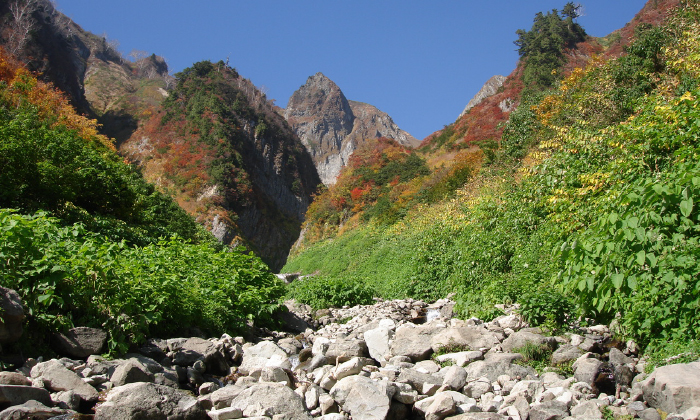
Characteristics
A Rallying Point of Volcanically Active and Non-volcanic Mountains
People's lives cradled in the workings of Mother Earth, and worships woven into scenery
People's lives cradled in the workings of Mother Earth, and worships woven into scenery
Date of Designation: March 27, 2015
Area: 39,772 ha
Related Prefecture: Niigata, Nagano
Area: 39,772 ha
Related Prefecture: Niigata, Nagano
Situated on the border of Niigata Prefecture and Nagano Prefecture, the Myoko-Togakushi renzan National Park is a new national park opened in March 2015 that straddles two prefectures and six municipalities: Itoigawa City, Myoko City, Nagano City, Otari Village, Shinano Town and Iizuna Town.
Though covering a small area, the park is densely packed with mountains with a distinct appearance that is characterized by a landscape of highlands scattered across the base of moutains, reservoirs, and lakes as typified by Lake Nojiri.
Above all, the park boasts diverse mountain structures of a volcanic mountain range, caldera, non-volcanic independent summit and a non-volcanic mountain range, as well as proactive mountain worship.
There are also the famous mountains Mt. Myoko and Mt. Takatsuma, which are listed in the Nihon Hyakumeizan (Hundred famous mountains in Japan), Mt. Iizuna; recommended for beginner mountaineers, and the steep Togakushi Mountain Range, where experts can also enjoy; all of which account for its great popularity as a field for mountaineering. In addition, the highland at the base of mountains attracts a large number of diverse visitors who are drawn to explore the nature in the summer, skiing and natural hot springs in the winter. This park area, on the other hand, is a heavy snowfall area, in which the harsh yet magnificent workings of nature, coupled with the unique culture and mountain worship, which received the bounty of nature, create a unique scenery only found in this part of the world.
There are also the famous mountains Mt. Myoko and Mt. Takatsuma, which are listed in the Nihon Hyakumeizan (Hundred famous mountains in Japan), Mt. Iizuna; recommended for beginner mountaineers, and the steep Togakushi Mountain Range, where experts can also enjoy; all of which account for its great popularity as a field for mountaineering. In addition, the highland at the base of mountains attracts a large number of diverse visitors who are drawn to explore the nature in the summer, skiing and natural hot springs in the winter. This park area, on the other hand, is a heavy snowfall area, in which the harsh yet magnificent workings of nature, coupled with the unique culture and mountain worship, which received the bounty of nature, create a unique scenery only found in this part of the world.
Terrain/ Scenery

Mt. Myoko in the Winter
Active Volcanos, Mt. Myoko and Mt. Yakeyama
Mt. Myoko is a double volcano (marked as a composite volcano) and exhibits its unique appearance majestically. From time to time, Mt. Yakeyama spews fumes even now.
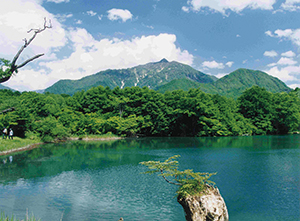
A view point in the Mt. Amakazari (Geosite) and the Shiroike Pond (outside the park)
Itoigawa Geopark
Situated at the westernmost point of Niigata Prefecture, the Itoigawa Geopark is a site to observe valuable geological conditions and distinct land features that show the formation of the Japanese archipelago as the Itoigawa-Shizuoka Tectonic Line (Ito Shizu Sen), which is a major fault on the west side of the Fossa Magna, runs through the area.
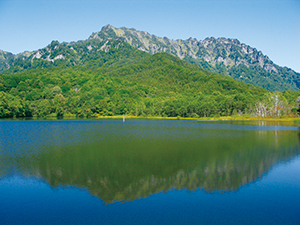
Togakushi Mountain Range seen from the Kagami Pond
The Togakushi Mountain Range Derived from an Underwater Volcano
There are many fossil shells found around the summit of Mt. Togakushi. This indicates that the Togakushi Mountain Range was formed by prominence and erosion from an underwater volcano, making it a site to witness the harsh yet beautiful landscape that is extremely distinct.
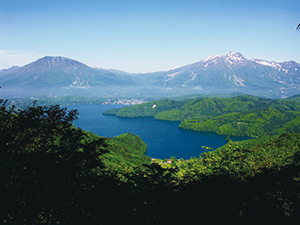
A panoramic view of Lake Nojiri viewed from the Sugekawa forest road. Mt. Kurohime and Mt. Myoko (from left.)
Mt. Kurohime and Lake Nojiri
The present Lake Nojiri was formed after a valley was stemmed by the lava that flowed from the Mt. Kurohime. The lake's extremely complicated lakeshores are also called Lake Fuyo for its shape and charming presence.
Plants
The northern slope of the Mt. Hiuchi, situated along the Sea of Japan, is a habitat of false alpine belt vegetation affected by the climate of heavy snow. Along the summits and ridgelines of the Myoko Mountain Range, thickets of creeping pine trees (at a height of 2,500 meters and below) grow and snow-covered highlands extend across the area, which are populated by the alpine plant of Primula cuneifolia Ledeb. var. hakusanensis makino.
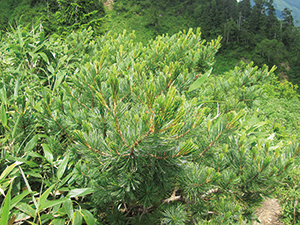
Creeping Pine Trees
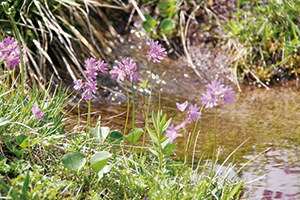
Primula cuneifolia Ledeb. var. hakusanensis makino
Additionally, the Koya Pond in the Mt. Hiuchi boasts vast high moors surrounded by cotton grass and crimson foliage, exhibiting beautiful scenes throughout all seasons.
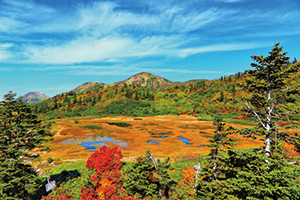
Crimson Foliage of the Koya Pond (From the mid to end of September)
From the Caltha palustris var. nipponica to Asian skunk cabbage famed as a white fairy, the sceneries of flowers that bloom in early spring during the thawing season are simply breathtaking.
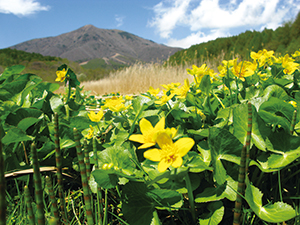
Caltha palustris var. nipponica and Mt. Iizuna
There is a distribution of natural beech trees across the park, as well as a deciduous broadleaf forest of Quercus crispula blume and Japanese white birch trees, forming a fascinating landscape.
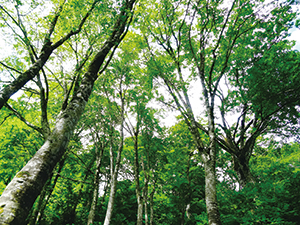
Japanese Beech Forests (at the foot of Mt. Amakazari)
The park is a habitat for valuable plant species indigenous to the areas along the Sea of Japan, including Aconitum nipponicum var. septemcarpum and Ranzania japonica.
Wildlife
Rock ptarmigan that makes its habitat in the vicinity of Mt. Hiuchi is the northernmost population for the species. As this population's habitat range is at a low elevation, it is susceptible to the effect of climate changes and considered an endangered species due to its small population.
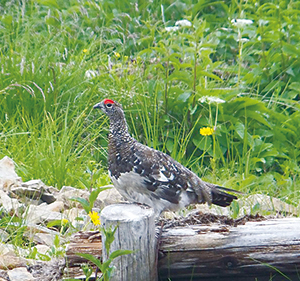
Male Rock Ptarmigan
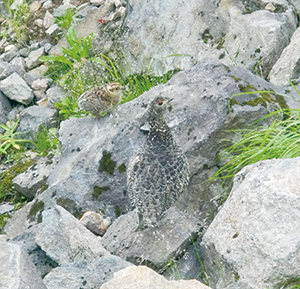
Female and a Chick of Rock Ptarmigan
The park in Togakushi area is a famous birdwaching site and more than 100 species are observed every year including migratory birds and resident birds such as Narcissus flycatcher, Eurasian wren, white-backed woodpecker, grey bunting and ruddy kingfisher. From the chestnut tiger to forest green tree frog, visitors can observe a wide range of wildlife from a close distance.
Culture
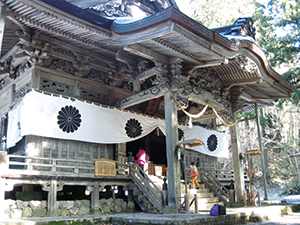
Togakushi-jinja Okusya Shrine (Hokosha Shrine)
Mountain Worship and the Togakushi-jinja Okusya Shrine
Mt. Togakushi and Mt. Iizuna have been regarded as the place of mountain worship where the believers practiced the Shugendo (Buddhist austerities) in days of old.

Japanese Cedar-lined Approach to the Okusya Shrine
The landscape created by its temple town retains the solemnity of historical facts. Also, the long row of Japanese cedar trees leading to the approach of the Okusya shrine is simply overwhelming.
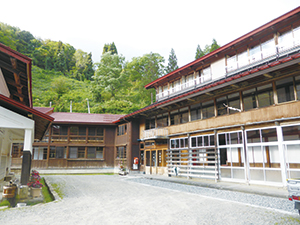
Otari Onsen
Onsen
The Otari Onsen, which is said to be discovered by a liegeman of Takeda Shingen, is a famous natural hot spring for its history of over 450 years.
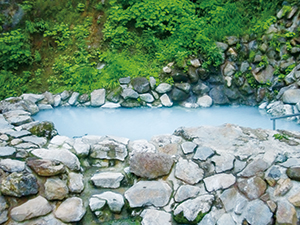
Tsubame Onsen (Open-air bath)
The foot of the Mt. Myoko has seven natural hot springs with five different types of spring quality and three different colors, making it a hot-spring village that is rich in variety and such a kind is rare in Japan.
Legends
The area is home to a variety of legends from the legend of ogress's autumnal tints in Togakushi and ninja arose from the Shugendo, making it a site to retrace the footsteps of culture.
